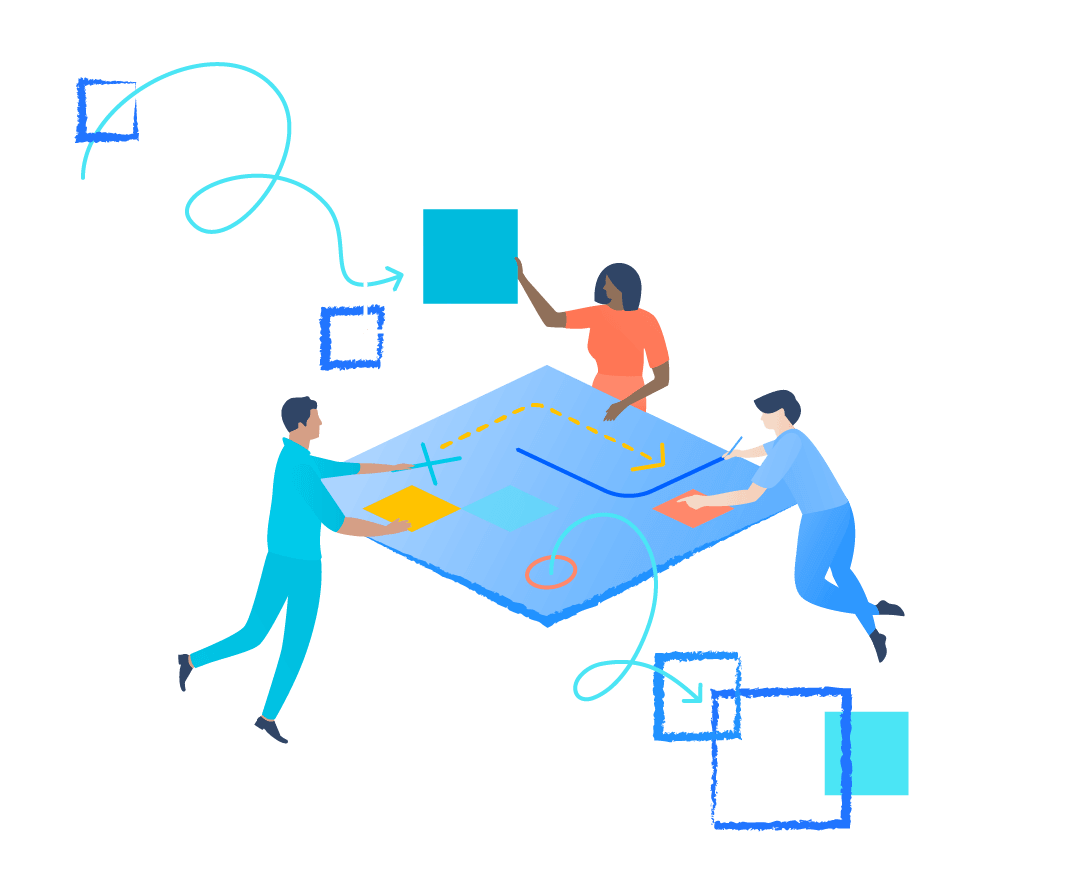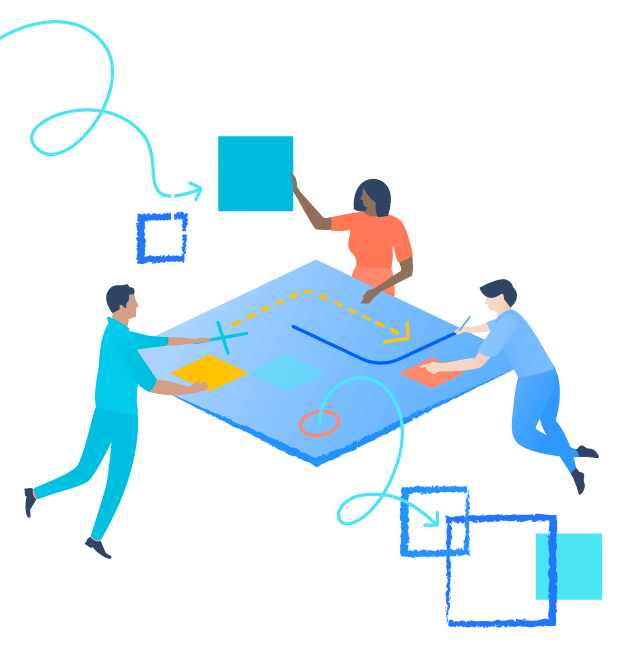Team Poster in action
The Atlassian Design System team uses a Confluence template to create their Team Poster.
The Cloud Enterprise Support team for Jira Service Management uses a Confluence template to create their Team Poster.
The Customer Ways of Working Practices team uses the Team Poster to share their purpose and vision.
What you'll need
Remote
Video conferencing with screen sharing
Digital collaboration tool
In-Person
Butcher paper
Red, yellow, and green markers
Notepads
Optional templates
Atlassian Templates
Instructions for running this Play
1. Prep: Leader 15 MIN
Prepare the team leader for center stage! Give them a heads up to prepare responses to two prompts:
What is this team’s purpose? For example: “As the marketing team, our mission is to provide solutions to our audience's biggest challenges with useful content.”
How do we fit into the broader vision? For example: “We are contributing to our company mission to unleash the potential of every team. We have a vision of being the experts in teamwork for our customers.”
If you are still defining the broader guidance for your team, a Project Poster can be a great place to start. Here, you'll outline project scope, identify the problems you're solving, and validate solutions. Your company mission and vision, combined with your business goals, can be a good starting point for defining your purpose. While we want to keep this page focused on the team’s area of responsibility, linking through to the broader, longer-term vision can inspire your audience and motivate them to collaborate.
TIP: Create your Usual Manual
A great way to help new team members, contractors, project teams, stakeholders, and network teams onboard onto your team quickly is to complete a User Manual that explains how you like to work.
2. Prep: Team members 10 MIN
Create a page to host the Team Poster — we recommend using the Confluence template. The team leader should review all of the elements of the page to ensure that they prepare answers to contribute to the conversation. For example: How will we measure success?
Schedule time for the team to run the Play together. Ahead of the meeting, share your draft Team Poster with your team to have each of them add their name, photo, location, role, and where possible, link to their User Manual in a Meet the team section of the Team Poster.
3. Share team context 15 MIN
Have the team leader present an overview of their prompts:
What is this team’s purpose?
How do we fit into the broader vision?
Each team member should provide at least one example of how this resonates to them, and what is still unclear. You can collaborate silently on your Team Poster document, or go around the room to update verbally. If your team is hybrid or remote, use a brainstorming document where everyone can collaborate simultaneously. Dedicate 1-2 minutes per team member during the meeting call to share examples virtually. The goal is to make sure that everyone has a shared understanding of the overall purpose of the team. No passes allowed!
If you haven’t already, document this team’s purpose at the top of your page:
Hello! We are [team name]. We are a [type of team] and our purpose is to [team purpose]. We have a vision of [broader vision].
For example: Hello! We are the content team. We are a delivery team and our purpose is to tell stories that align with the product’s mission to make meal planning easier for every parent. We have a vision of becoming experts in making every family happy and healthy.
Include links at the top of the page to your team directory listing, project, and goals in Atlas. As you move through each section of the page, feel free to add links to any existing research or prior work done. You will continue to add to this living document as your team delves deeper into the work.
Now your team will discuss each of the below questions to build the story of what your team is seeking to achieve, for whom, why, and how you’re going to go about it. Spend a short amount of time on each. Rather than getting stuck by going deep on each topic, set the timer and get through the whole picture in a low fidelity as a first draft. This is a living document - so you can return to flesh out each category.
TIP: Create your Working Agreements
Help colleagues and team members understand how best to engage with your team. Complete your team’s Working Agreements to determine the who, when, where, why, and what of your team's meetings and rituals.
4. What problem(s) are we solving? Why? 5 MIN
Start by considering the core problems that your team is seeking to solve. For example, are you looking to reduce customer service response times? Do you want to increase the speed of your platform?
Then, layer on the why. Why do your customers or the business care about solving this problem? For example, is it so that they can get back to doing their best work? Is it so that they can enjoy the product they have purchased as intended? You will layer in more business outcomes in step 6.
5. Who are our customers? 5 MIN
Who are you looking to serve? We have a suite of Plays that can help you to gain a Shared Understanding of your customer as a team; try running a Customer Interview, creating a Customer Journey Map, Empathy Mapping, or ideally creating an Experience Canvas.
6. How will we measure success? 5 MIN
What business and experience metrics will let you know that you have been successful? How will you know that you are on track? Try our Team Goals, Signals, and Measures Play to refine your success criteria. Lead with SMART goals: Specific, Measurable, Achievable, Relevant, and Time-bound. This will guide your strategy and help you measure success from project to project.
7. What solutions do we currently offer? 5 MIN
What solutions do customers currently have access to that this team creates or supports? What does BAU (Business As Usual) look like for your team? Analyze: are these solutions effective? What customer feedback have you received so far?
8. What strategy are we working on delivering currently? 5 MIN
What is your strategic direction for the next year? Are there specific milestones or events that are being targeted? What tactics do you have in mind to achieve your goals? This context is crucial in helping build understanding on why certain work is being prioritized over other opportunities.
9. FAQs 5 MIN
How often does your team get the same questions repeatedly? Do you Have a complex dependency structure with another team, or recently take on a new remit? Capture your frequently answered questions in a dedicated section.
10. Contact us 5 MIN
Finish the page by documenting how teams can get in contact with you, such as your open Slack channel, Atlas directory listing, Jira Service Desk, or Form. Identify roles and responsibilities across the team so others know who to contact for what and when. Your engineering lead shouldn't be getting flogged by questions about design strategy, and your customer experience strategist shouldn't field questions on project management.
Bonus points for completing Working Agreements and adding your regular meetings and rituals to the page with links to the agendas and minutes.
Follow-up
Use your Team Poster as your team’s homepage and reiterate these missions with every new project or sprint. As you work with others, share with your stakeholders and network teams to educate on your team’s purpose. Weave the Team Poster into your regular onboarding to ensure everyone on your team is aligned as they begin to work with you.
Remember that this is a living document. As your team changes and grows, so will your team's purpose and mission. Revisit this page at least every three months, or whenever the team pivots, to sense-check if this page still captures the reality of your team’s purpose and structure.
From our team, to yours
Stay up-to-date on the latest Plays, tips, and tricks with our monthly newsletter.

